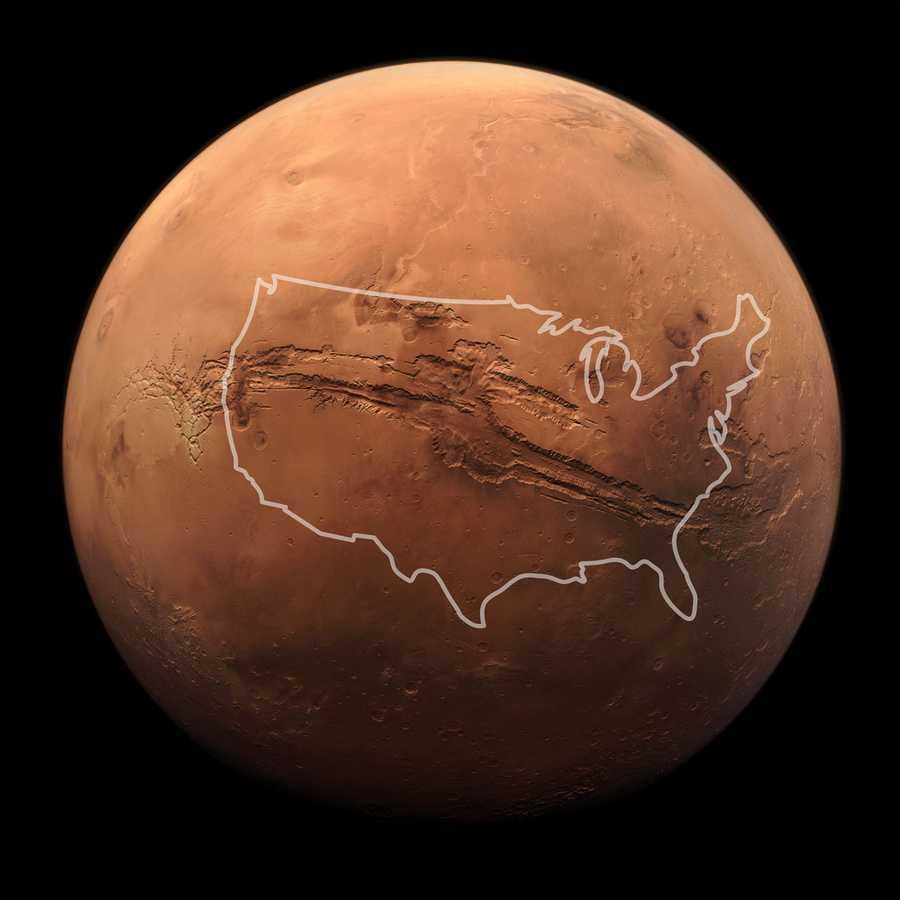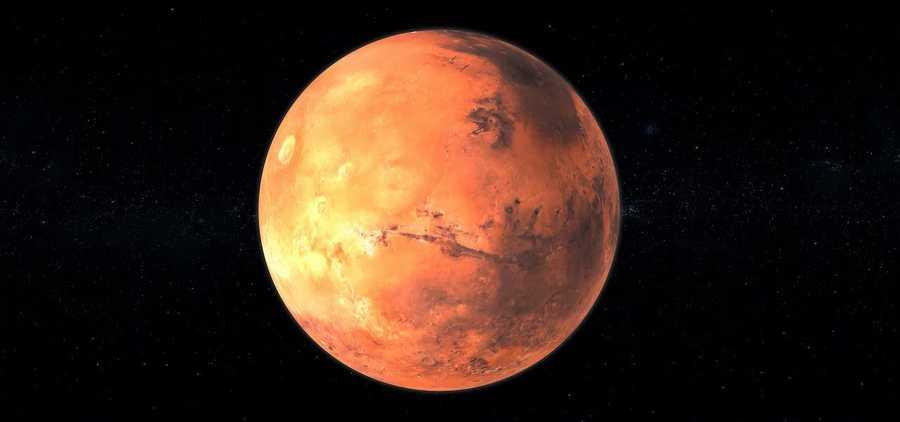Surface
The red planet is actually many colors. At the surface, we see colors as brown, gold, and tan. The reason Mars looks reddish is due to oxidization—or rusting—of iron in the rocks, regolith (Martian “soil”), and dust of Mars. This dust gets kicked up into the atmosphere and from a distance makes the planet appear mostly red.
Interestingly, while Mars is about half the diameter of Earth, its surface has nearly the same area as Earth’s dry land. Its volcanoes, impact craters, crustal movement, and atmospheric conditions such as dust storms have altered the landscape of Mars over many years, creating some of the solar system's most interesting topographical features.
A large canyon system called Valles Marineris is long enough to stretch from California to New York—more than 3,000 miles (4,800 kilometers). This Martian canyon is 200 miles (320 kilometers) at its widest and 4.3 miles (7 kilometers) at its deepest. That's about 10 times the size of Earth's Grand Canyon.
Mars is home to the largest volcano in the solar system, Olympus Mons. It's three times taller than Earth's Mt. Everest with a base the size of the state of New Mexico.
Mars appears to have had a watery past, with ancient river valley networks, deltas, and lakebeds, as well as rocks and minerals on the surface that could only have formed in liquid water. Some features suggest that Mars experienced huge floods about 3.5 billion years ago.
There is water on Mars today, but the Martian atmosphere is too thin for liquid water to exist for long on the surface.
Today, water on Mars is found in the form of water-ice just under the surface in the polar regions as well as in briny (salty) water, which seasonally flows down some hillsides and crater walls.
24
37 reads
CURATED FROM
IDEAS CURATED BY
I'm passionate about helping people live their best lives. I'm a lifestyle coach & burnout coach.
The idea is part of this collection:
Learn more about scienceandnature with this collection
The importance of physical activity
The role of genetics in lifespan
How to maintain a healthy diet
Related collections
Similar ideas to Surface
Why explore Mars
When scientists view the Martian surface, they see branching streams, river valleys, basins, and deltas, suggesting that the planet may have once had a vast ocean covering its northern hemisphere. It was likely wrapped in a thick atmosphere able to maintain liquid water.
...
Mars
Mars was named by the ancient Romans for their god of war because its reddish color was reminiscent of blood.
Other civilizations also named the planet for this attribute; for example, the Egyptians called it "Her Desher," meaning "the red one." Even today, it is frequently called the "Red...
Mars: Past missions, major discoveries
Since 1960, dozens of spacecraft have been sent to Mars. It is difficult to send a spacecraft to Mars and even harder to land on the planet because of the thin atmosphere.
Data revealed the largest volcanoes in the solar system and one of the largest canyons yet discovered. Dust storms reg...
Read & Learn
20x Faster
without
deepstash
with
deepstash
with
deepstash
Personalized microlearning
—
100+ Learning Journeys
—
Access to 200,000+ ideas
—
Access to the mobile app
—
Unlimited idea saving
—
—
Unlimited history
—
—
Unlimited listening to ideas
—
—
Downloading & offline access
—
—
Supercharge your mind with one idea per day
Enter your email and spend 1 minute every day to learn something new.
I agree to receive email updates

